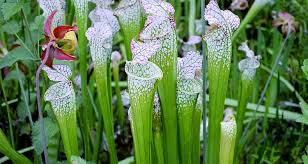







Defensive Strategies and Molecular targets
Plants need to be able to defend against a wide variety of attackers. This requires a broad spectrum of activity, because a substance that might keep a caterpillar away might be some bettle's fancy. To answer this need plants have adopted a strategy that is universally effective; they have developed secondary metabolites that modify functional proteins (essentially receptors and enzymes) in the largest organism, thereby modifying the processes these proteins perform
They can be a highly effective deterrent , since proteins performing the functions of receptors and enzymes are the main players in practically all cellular processes.
Upsetting the functioning of the enzymatic processes performed by these proteins can significantly deter an attacker. Secondary metabolites perform their defensive tasks in two principal ways, Some interact selectively with specific receptors, but a majority operate in nonselective ways.
Scientific Context - Plant Evolution, a Summary
The Beginning
Earth is 4.5 billion years old - Fossils are 3.5 billion years old - The first cells consisted of carbon, oxygen, hydrogen, and nitrogen - 98% of all living organisms are composed of these elements.
Photosynthesis Changed earth's Atmosphere
Self-sustaining (autotrophic began to split water (H2O) into the atmosphere.
As the 02 in the atmosphere converted to 03 the o3 became sufficient to absorb UV light.
Organisms protected from UV by the ozone layer began to develop 450 million years ago.
The increased availability of O2 - originally toxic to the anaerobic organisms-was turned into a virtue. Respiration developed.
Humans Need Plants
Chlorophyll enables photosynthesis - Photosynthesis transforms light energy into chemical energy usable by living organisms - Photosynthesis is the connection between animate and inanimate nature : it is the means by which self-sustaining or self-nourishing (autotrophic) cell-like structures generate organic molecules from simple inorganic molecules.
Plants are autotropic; they can generate the carbohydrates they need from the Co2 in the air. Humans are heterotrophic dependent upon nourishment by intake and digestion or organic matter. Human survival is completely dependent on plants.
Prokaryotes and Eukaryotes
There are two categories of cells: prokaryotes and eukaryotes. Before oxygen accumulated in the atmosphere there were only prokaryotic cells (bacteria and blue green algae, characterized by a simple naked chromosomes). As oxygen became abundant eukaryotic cells (with chromosomes in a nucleus, separated from cytoplasm by membranes) arose.
Prokaryotes: Single-celled Organisms without a Nucleus
Prokaryotic cell DNA is not attached or contained in a nucleus. Prokaryotic cell size ranges from 0.1 to 1 micrometer ( 1 micrometer equals one thousandth of a millimeter. Prokaryotic cells have no internal compartments or cytoskeleton.
Eukaryotes: Cells with compartments or organelles
Organelles are specific areas of the cell, housing specific physiological processes separated by enclosing biological membranes or biomembranes, they include:
Nucleus (the major organelle, separating the chromosomes from the cytoplasm)
Mitochondria (highly variable structures containing many enzymes)
Vacuole (large vesicles)
Plastids (often containing elaborate internal membrane systems, the best-known representative being the chloroplast that houses photosynthesis)
Golgi apparatus ( an intracellular stack of vesicles in which packaging of secreted proteins takes place)
Endoplasmatic reticulum (membrane system that branches out through the cytoplasm of the cell)
Reference: The Healing Intelligence of Essential Oils: Kurt Schnaubelt, Ph.D.
Articles Latest
- CARDAMON
- CARAWAY
- CANANGA
- CAMPHOR
- CALAMUS
- Calamintha-Calamintha officinalis
- CAJEPUT- Melaleuca cajeputi
- Plant Expression
- Molecular Target: Cell Membrane
- CADE Essential Oil
- CABREUVA
- The Kashmiri rose oil worth millions
- Agarwood: The natural treasure worth more than gold whose heady scent is driving it towards extinction
- Nonselective Binding to Proteins: The Science of Advanced Aromatherapy
- Molecular Target: DNA, RNA, and Gene Expression
- BUCHU - Agothosma betulina
- BROOM - SPANISH - spartium junceum
- BORONiA - Boronia megastigma
- BORNEOL - Dryobalanops aromantica
- Boldo Leaf - Peumus boldus
- Birch White-Betula Alba
Articles-Most Read
- Home
- Balsam Canadian - Abies balsamea
- Copaiba Essential Oil
- Balsam Peru
- Basil French - Ocimum basilicum
- North America: Tea Tree and Monarda-3
- Basil Exotic
- North America: Tea Tree and Monarda-2
- Exploring Transcultural Constants
- Thyme Essential Oil
- Balsam Tolu
- Palma Rosa
- The Bioactivity of Essential Oils
- Benzoin - Styrax benzoin
- Why Pharmacology Cannot Demonstrate Essential Oil Efficacy
- Bay - West Indian - Pimenta racemosa
- Exploring Essential Oil Activity The Conventional Way
- Aromatherapy: An Answer
- Complex information From Plants
- Contacts
